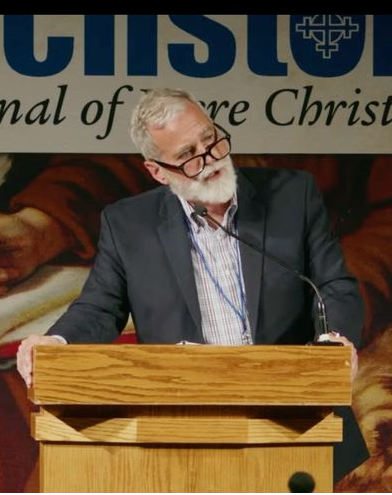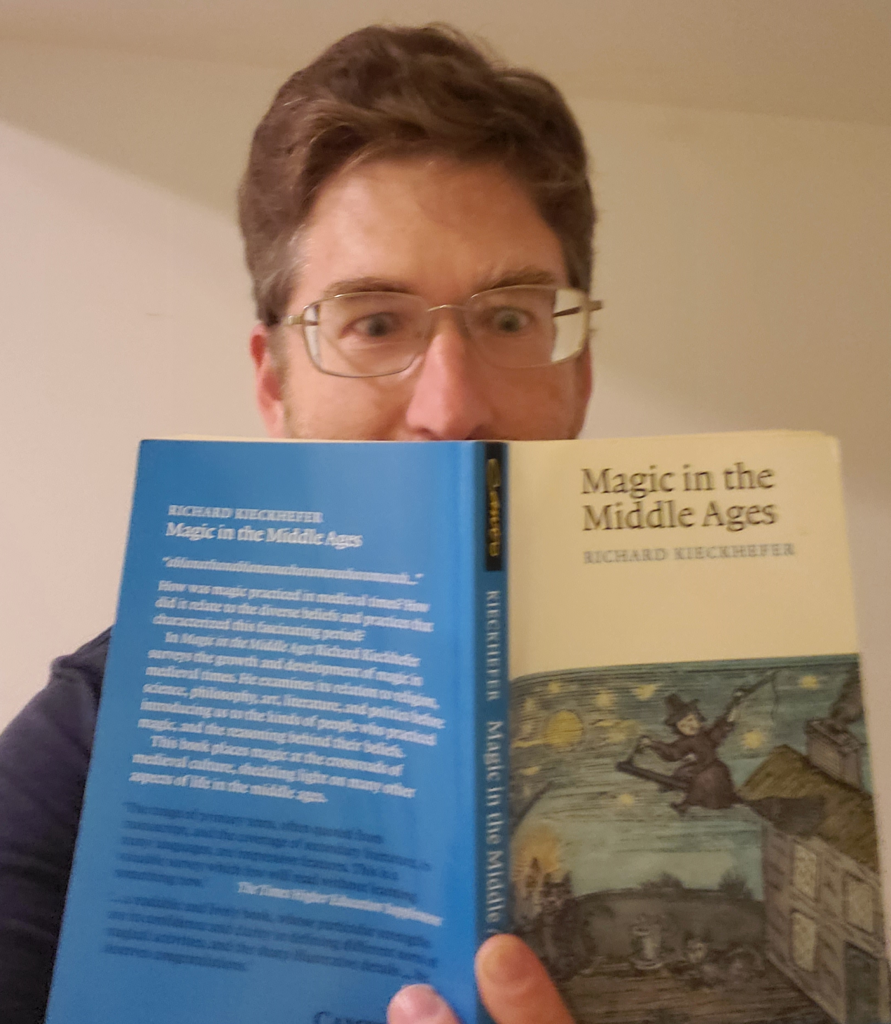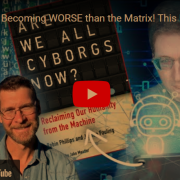 During the recent Touchstone Conference, C.R. Wiley explained how the dream of Lewis’s Screwtape has finally been realized: we now live in a land of materialist magicians. As he put it, “The material magician that Lewis saw coming is now here, and their incantations threaten to take possession of us. Will we allow ourselves to be hacked or will we resist?”
During the recent Touchstone Conference, C.R. Wiley explained how the dream of Lewis’s Screwtape has finally been realized: we now live in a land of materialist magicians. As he put it, “The material magician that Lewis saw coming is now here, and their incantations threaten to take possession of us. Will we allow ourselves to be hacked or will we resist?”“Eric Voegelin famously warned us not to ‘immanentize the eschaton.’ Everyone who has attempted it—from Shakers to Maoists—have sterilized themselves or left smoldering holes where cultures used to be. Transhumanists have shifted the focus of an over-realized eschatology from social life to biology. They’re seeking godhood without God, and a resurrection without a final judgment. They will fail. Don’t buy it.”
Significantly, it is not merely from the transhumanist community where we witness this type of hubris. As Wiley also pointed out, there is an increasing mystical tone that now permeates even mainstream discourse on technology throughout Silicon Valley. In some sense, this has been correlative to a larger cultural drift toward neopaganism. As Joshua Pauling and I point out in chapter 12 of Are We All Cyborgs Now?,
As the spiritual becomes technological and the technological becomes spiritual, we are witnessing a return of primal fears long suppressed, including types of religious superstition associated with past ages of human history. Consider: pre-modern men and women were obsessed by how their lives were controlled by non-human agents, and we too seem haunted by the primal angst of invisible phenomena exerting causal power over human affairs. It is no longer angels and demons with which we must contend, but proprietary algorithms, data in “the cloud,” and invisible bots that mysteriously organize our lives and whose caprices must be pacified through an ever-expanding network of rituals, code-words, and esoteric knowledge.
Within this new quasi-spiritual paganism, the language of magic is becoming increasingly commonplace, bursting onto the mainstream with Joshua Schrei’s much-discussed essay “AI in the Age of Mythic Powers.” What Schrei succeeded in doing was to bring the language of magic from its transhumanist margins into the mainstream technological discourse within the developer community. “Trances, spells, illusions, manipulations are everywhere,” Schrei observed, adding “the entire sociocultural agreement around media and the degree to which media runs our lives is what you could call a magical pact.” Schrei continued:
And the programming architects at the center of this magic have been very open about it. They’ve directly said over the years that the AI issue is more religious than scientific. Some have even compared themselves directly to sorcerers… Writers and philosophers and even some AI architects themselves have said since the 60s that the fundamental questions underpinning AI are actually religious questions. Questions of apocalypse, salvation, of power and sentience. These are deeply important questions — and AI is bringing all of them to the surface. And showing us yet again, that the world we inhabit is mysterious, and the primary questions facing us are spiritual questions.
“
“Magic” is a tricky term that requires a careful definition—four definitions, in fact.
Magic originally meant “the arts of the magi,” to reference the skills and knowledge of Zoroastrian priests from Persia whose influence extended to the classical world and Southern Europe. The learning of these magi, no less than their claims to cure people through mysterious ceremonies, seemed exotic to those in the Mediterranean lands and accounts for the association between “magic” and the exotic that remains to this day.[1]
In time, Christians encountered “magic” from sources other than the magi. As Christendom expanded into Europe, believers confronted witches and wizards who used practices like divination, fortune-telling, sorcery, and necromancy to manipulate non-human intelligences. Thus, we can posit our first definition of magic.
- Definition #1). The use of techniques and mechanisms to manipulate and communicate with non-human intelligences.
In the Middle Ages, the term magic was mainly confined to philosophical and theological literature. On ground level, however, it was not always clear when a special cure or procedure might involve licit knowledge from philosophia naturalis (what later becomes natural science) or magic, or a combination of both. We see this in the trope of the witch who is learned in both herbology and, so-called, magic potions (the magic potions themselves often concocted from knowledge of plant lore). “The word magic is mainly an abstract and analytical term used in the theological literature. Practitioners more often described the purposes their operations served (e.g., healing, cursing, arousing love), without troubling to place these operations in an abstract category such as magic.”[2]
Around the thirteenth century, some thinkers began to address this ambiguity by distinguishing between demonic magic and “natural magic,” the latter including the marvelous and hidden (occult) powers, processes and procedures of nature that would later fall under natural science. This included many natural powers or processes (including those we no longer consider scientific, such as alchemy, the special powers of gemstones, the influence of the planets on terrestrial life, etc.), and differed from the manifest powers of a thing that could be explained without reference to external forces.[3] Some thinkers, like Aquinas and Robert Bacon, reserve “magic” for things involving sorcery and divination and use virtutes occultae (occult powers) to describe hidden powers in nature. But most medieval people did not make such a distinction although they may have had a vague understanding of the difference between white and black magic. On ground level, however, these distinctions tended to be blurry, and few people would have been able to specify the difference between a charm and a cure. With these qualifications in mind, we can posit our second definition of magic:
- Definition #2). Natural magic, where one deals with marvelous and hidden properties and processes of nature.
In practice, natural magic was believed to have the potential to produce results that might appear, on the surface, like illicit magic. We see this in the famous story of the mechanical head constructed by Thomas Aquinas’s teacher, Albertus Magnus. The author of a 1337 text describing the head is at pains to clarify that while the mechanical head could speak and reason (essentially an early version of AI), it was not through demonic power but instead through the great philosopher’s knowledge of the planets and their rotations.
We find that Albertus Magnus, of the Preaching Friars, had such a great mind that he was able to make a metal statue modeled after the course of the planets, and endowed with such a capacity for reason that it spoke: and it was not from a diabolical art or necromancy—great intellects do not delight in such things because it is something that makes one lose his soul and body; such arts are forbidden by the faith of Christ. One day a monk went to find Albertus in his cell. As Albertus was not there, the statue replied. The monk, thinking that it was an idol of evil invention, broke it. When Albertus returned, he was very angry, telling the monk that it had taken him thirty years to make this piece and “that I did not gain this knowledge in the Order of the Friars: The monk replied, “I have done wrong; please forgive me. What, can’t you make another one?” Albertus responded that it would be thirty thousand more years before another could be made, as that planet had made its course and it would not return before that time.[4]
The story of Albertus Magnus’s talking head is also valuable in indicating that even in a pre-scientific age, medieval man understood the distinction between something powered by demonic arts, and something powered by natural and mechanical means, though the monk in the story mistook the latter for the former. This story also illustrates how the influence of the planets, though part of virtutes occultae, was seen as separate from the diabolical arts, and more aligned with what we would call science. Yet in practice, the distinction between planetary influence and demonic influence was often blurry, as seen in the legend of the werewolf, whose demonic abilities were, in some sense, powered by the full moon.
Thus, we can posit our third definition of magic.
- Definition #3). Automata / robots.
Medieval man also understood stage magic—sleight of hand. When discussing types of magic, John of Salisbury’s (1120–1180) includes illusions (praestigia). We need not dwell on this but can simply posit a fourth definition of magic.
- Definition #4). Prestidigitation or “sleight of hand.”
What is curious about our digital technology, and especially AI, is that it integrates all four of the medieval senses of magic. Let’s start with the fourth and work backwards.
Clearly, people can perform various tricks with AI, such as perpetuating the growing illusion that chatbots are sentient . Even the term “artificial intelligence” hinges on the illusion that these systems actually think in what amounts to a digital sleight of hand.[5]
But these systems are also magical in sense #3, as they represent a modern equivalent of Albertus Magnus’s talking head.
These systems also involve magic in the second sense, where one manipulates the marvelous and hidden properties and processes of nature. Though we do not still use the medieval distinction between manifest and hidden powers, if ever anything qualified for the latter it would be AI. Consider, AI involves harnessing the hidden properties of the world (i.e., electrical energy, magnetism, optics), just as it involves discovering the hidden processes of nature (i.e., the processes we’ve discovered for turning rocks into mechanical heads, which is to say, to turn quartz into the high-purity single-crystal silicon wafers used in microprocessors).
What is perhaps especially fascinating is to see AI increasingly harnessed for the first sense of magic, as people believe they can use it to communicate with non-human intelligences—both those thought to reside in the systems themselves as well as intelligences within the spirit realm (for examples, see my article for The Symbolic World, “Technology & the Story of Redemption: Being the People of God in a Mechanized World.” While it may come as a surprise, the leaders of some of the largest tech companies in the world are hoping to use AI to merge with non-human intelligences in a coming synthesis of biological and digital life. Clearly, this qualifies as magic according to the first sense, namely the use of techniques and mechanisms to manipulate and communicate with non-human intelligences.
Thus, it is no exaggeration to say that today’s technological enterprise, and the larger scientific endeavor that undergirds it, is the true successor of ancient magic. As C.S. Lewis explained in The Abolition of Man.
The fact that the scientist has succeeded where the magician failed has put such a wide contrast between them in popular thought that the real story of the birth of Science is misunderstood. You will even find people who write about the sixteenth century as if Magic were a medieval survival and Science the new thing that came to sweep it away. Those who have studied the period know better. There was very little magic in the Middle Ages: the sixteenth and seventeenth centuries are the high noon of magic. The serious magical endeavor and the serious scientific endeavor are twins: one was sickly and died, the other strong and throve. But they were twins. They were born of the same impulse… There is something which unites magic and applied science while separating both from the “wisdom” of earlier ages. For the wise men of old the cardinal problem had been how to conform the soul to reality, and the solution had been knowledge, self-discipline, and virtue. For magic and applied science alike the problem is how to subdue reality to the wishes of men: the solution is a technique; and both, in practice of this technique, are ready to do things hitherto regarded as disgusting and impious—such as digging up and mutilating the dead.[6]
If Lewis were writing today, he might choose different examples, such as “resurrecting” the dead and mutilating the living. He would also find more than abundant confirmation for this understanding that, far from sweeping magic away as is often thought, modern science and engineering stands in continuity to the quest of the ancient magician.
References
[1] Richard Kieckhefer, Magic in the Middle Ages (New York, NY: Cambridge University Press, 2004), 10.
[2] “Magic: Magic in Medieval and Renaissance Europe .” Encyclopedia of Religion. Encyclopedia.com. (April 15, 2024). https://www.encyclopedia.com/environment/encyclopedias-almanacs-transcripts-and-maps/magic-magic-medieval-and-renaissance-europe
[3] These were distinct from manifest powers in nature. A power of an object, say a plant, that cannot be explained by its own properties, is a power hidden from the senses and thus occult. But this did not mean “spiritual” in the modern sense. “The power of a plant to cure certain ailments, or the power of a gem to ward off certain kinds of misfortune, may derive not from the internal structure of the object but from an external source: emanations coming from the stars and planets. These latter powers were technically known as occult, and natural magic was the science of such powers. The properties in question were strictly within the realm of nature, but the natural world that could account for them was a broad one: instead of examining the inner structure of a plant to determine its effects, one had to posit influences that flowed from the distant reaches of the cosmos.” Richard Kieckhefer, Magic in the Middle Ages (New York, NY: Cambridge University Press, 2004), p. 12-13.
[4] From the Rosaio della vita, cited in Minsoo Kang and Ben Halliburton, “The Android of Albertus Magnus: A Legend of Artificial Being,” in AI Narratives: A History of Imaginative Thinking about Intelligent Machines, ed. Stephen Cave, Kanta Dihal, and Sarah Dillon (New York, NY: Oxford University Press, 2020).
[5] See Charley Johnson, “The Illusion of ChatGPT,” Untangled with Charley Johnson, February 26, 2023, https://untangled.substack.com/p/the-illusion-of-chatgpt.
[6] C.S. Lewis, The Abolition of Man (New York: MacMillan, 1994), 83-84.


